Notable Submarine Accidents
From PigBoats.COM
Notes
The pigboats era of 1900-1940 is notable for several reasons, not the least of which is the fact that submarine technology was in its infancy; the USN was learning the limits of what this new technology could do and what it couldn't. The pigboats were pathfinders in a very real sense, and sometimes that meant that dangerous unknowns were encountered. When combined with normal human fallibility, those unknowns sometimes resulted in a smashed-up submarine, and unfortunately at times our submarine brethren paid a steep price for their pathfinding service.
This section is meant to highlight some of the notable accidents that befell our Submarine Force during the pigboats era. The purpose is to honor the bravery and sacrifice of the men involved, and to show that the Navy persevered and learned from its mistakes. The technology matured and submarines got safer, but sailing a ship under the sea will never be a safe activity. This list is not all-inclusive, nor will it tell the full tale of each incident. It will give an overview and highlight some of the photographs that Ric has collected over the years. Many of these incidents have been covered in depth by other authors, and when possible we will provide links to books that we know will tell the full tale.
F-4 (Submarine No. 23), Hull failure during a test dive, March 25, 1915
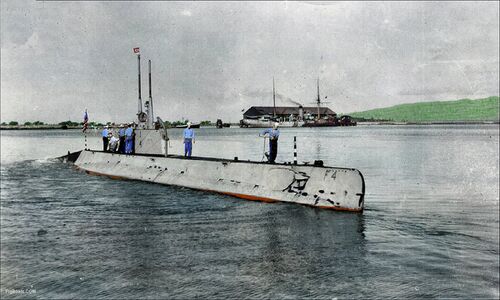
F-4 got underway for a completely routine one day training voyage from her base in Honolulu Harbor, HI. on the morning of March 25, 1915. What no one knew at the time was that acid from her lead-acid battery cells had seeped out of the cells and had gathered on the steel plating lining the bottom of the battery well, which was also part of the pressure hull. Accumulated over a period of months, the acid had gradually eaten away at the steel until the fateful day of March 25. While she was submerged during a routine training dive, the weakened hull developed a bad leak that led to a loss of depth control. When the boat passed crush depth the hull catastrophically imploded and F-4 sank with all hands. There were no survivors. Five and a half months later, after a herculean effort involving unparalleled bravery and incredible ingenuity, F-4 was raised from 306 feet (92.3 m) of water and returned to Honolulu where she was drydocked and inspected. The remains of her crew were removed and given a hero's procession through Honolulu before they were returned to the mainland for burial. After the completion of the accident investigation, F-4 was stripped of any useful equipment and her hulk was towed to Pearl Harbor where it was dropped in the shallow waters of the then unused Magazine Loch. 25 years later it was found that her wreck was in the way of the rapidly expanding Submarine Base so a trench was dug next to the wreck and she was rolled into it. This got her out of the way and allowed the base to continue its expansion. She remains there to this day, just a few yards off berth S13.
PigBoats.COM is proud to display a collection of photographs of her salvage and those are presented here. In addition, the webmasters provided author Jon Humboldt Gates with technical advice for his book Before the Dolphins Guild which tells the story of the loss of the F-4.
A-7 (Submarine No. 8), Gasoline explosion and fire, July 24, 1917
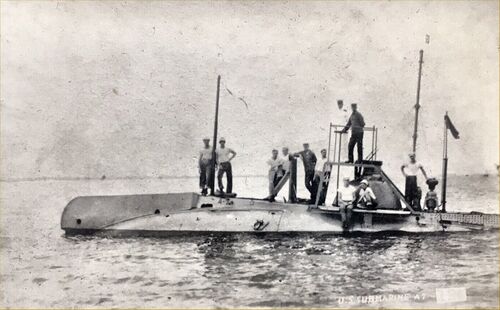
On July 24, 1917, while running a patrol in Manila Bay, Philippines, gasoline fumes ignited and caused an explosion and fire. The engine of the submarine been overhauled a short time before. The crew battled the fire until the Captain ordered the men topside and into boats that had pulled alongside. Six men later died from the effects of the fire. LTjg Arnold Marcus, the submarine's commanding officer, died the next day, July 25, 1917. He refused treatment until all of his men had been treated. Shark was never returned to patrol duty, the effects of the fire being so great. Essentially a total loss, she was decommissioned for the last time December 12, 1919 and struck from the Navy List on January 16, 1922. She was later sunk as a target off Corregidor. Please see this link for more information
F-1 (Submarine No. 20), Collision with F-3 (Submarine No. 22), December 17, 1917
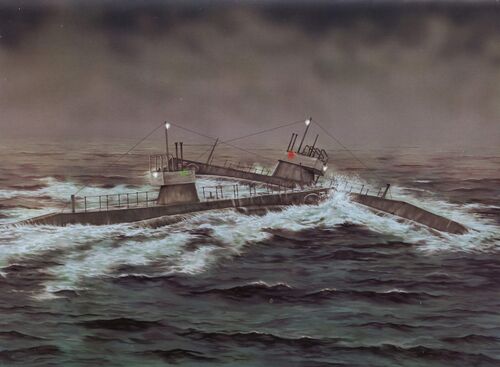
While steaming in formation on the night of December 17, 1917, F-3 collided with F-1 in a heavy fog off the coast of La Jolla, California near Point Loma. F-3 struck her sister on the port side in the engine room. F-1 sank in just a few seconds, but not before the four men on her bridge and one man in the conning tower escaped. They were rescued by F-3. 19 men made their last dive. F-1 sank in 1453 feet (442.9 m) of water, far too deep for salvage. In 1986 her wreck was visited for the first time by the Deep Submergence Rescue Vehicle Avalon (DSRV-2) while on a training mission. Avalon obtained several pictures of her wreck site that we can display here.
O-5 (SS-66), Battery explosion, October 5, 1918
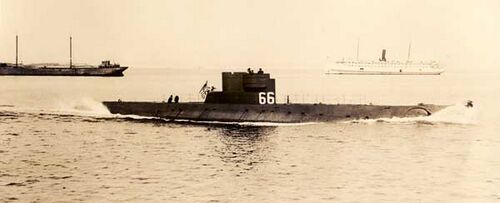
On the morning of October 5, 1918, while alongside a pier at the Brooklyn Navy Yard, O-5 started her engines to conduct a battery charge. A few minutes later LTjg William Sharkey noticed that the batteries were producing hydrogen gas and he alerted the commanding officer, LCDR George Trever. They both headed forward into the after battery compartment. Shortly thereafter the battery exploded, killing Sharkey and mortally wounding Trever. Trever would pass away on October 14. Both men were posthumously awarded the Navy Cross for their actions and bravery. O-5 was repaired and returned to service, but had a black cloud following her (See below).
S-6 (SS-111), Collision with a destroyer, 1922
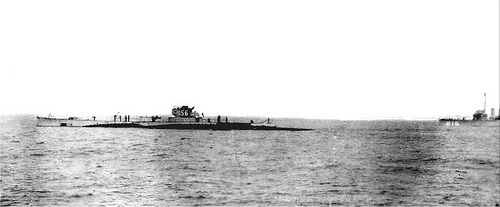
We do not have a lot of details concerning this incident, but we do have several photos gifted to us by the family of Charles Townsend, a former crewmember of S-6. The collision occurred during maneuvers off the coast of Luzon, Philippines in approximately 1922. S-6 was submerged when she was struck by one of the destroyers she was exercising with. The destroyer struck the periscope shears, heavily damaging both periscopes and causing significant structural damage to the shears. As far as can be determined, no one was killed or injured. S-6 was fully repaired and returned to service. S-6 was lucky. This could have turned out a lot worse. This photo shows S-6 shortly after she surfaced following the collision. The USS Borie (DD-215) is in the background.
S-51 (SS-162), Collision with merchant ship, September 25, 1925
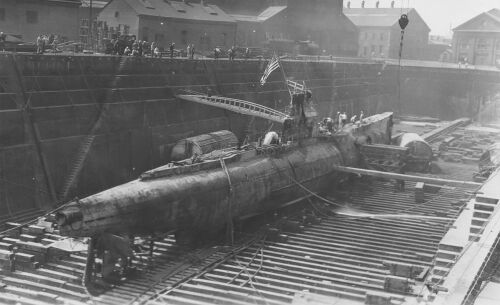
S-51 sitting forlornly in drydock at the Brooklyn Navy Yard, July 9, 1926. The previous September the S-51 had been operating off of Block Island in Long Island Sound. Late in the evening of September 25, S-51 was struck on the port side in the battery compartment by the Steamship City of Rome. She sank immediately, with only three men out of her crew of 36 surviving. The next ten months saw a herculean effort by the Navy to salvage the sunken boat and retrieve the remains of the crew still entombed in the ship. By the time the boat was returned to the Brooklyn yard, she was thoroughly wrecked. She was never returned to service and was decommissioned and scrapped. The Navy learned a lot from this salvage operation, and they put that knowledge to good use two years later when the S-4 (SS-109) was lost under similar circumstances. The story of the S-51's sinking and salvage is a classic of the sea service. The man in charge of the salvage operations, LCDR (later RADM) Edward Ellsberg wrote a timeless tale of the work and published it as On The Bottom in 1929. It is very well written and we give it our highest recommendation. PigBoats has a collection of photographs from this operation and they are displayed here.
In addition, a granddaughter of one of the lost crewmen maintains an excellent informational site on the accident, which can be accessed at the enclosed link.
In addition, a granddaughter of one of the lost crewmen maintains an excellent informational site on the accident, which can be accessed at the enclosed link.
S-4 (SS-109), Collision with USCGC Paulding, December 17, 1927
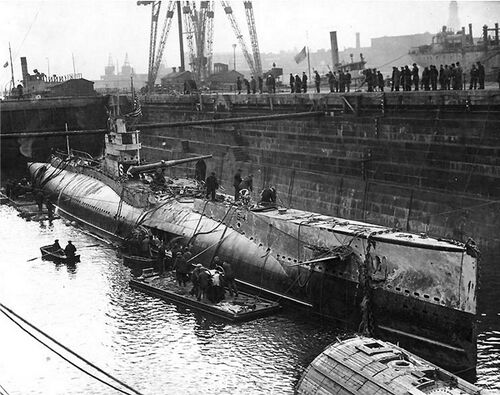
USS S-4 (SS-109) served the Navy well for nearly 16 years, but her career was marred by at tragic accident that occurred on December 17, 1927. On that date she was conducting submerged trials on the measured mile in Cape Cod Bay off Provincetown, MA. While coming to the surface at the end of the run, she was accidently rammed by the Coast Guard Cutter Paulding (CG-17). S-4 sank immediately with her entire crew, but six men were still alive in the forward torpedo room. A frantic rescue effort followed, but it was not successful and the entire crew perished. The boat was subsequently salvaged and partially reconditioned, but it was not returned to full service. Instead, she was used as a test bed to develop new technologies and techniques for submarine escape, rescue, and salvage. She was finally decommissioned in 1933 and eventually scrapped. She is shown here in drydock following her salvage at the Boston Navy Yard, March 19, 1928. We have a series of photos that depict the subsequent salvage efforts at this link. The webmasters can also highly recommend the book Seventeen Fathoms Deep: The Saga of the Submarine S-4 Disaster by historian Joseph A. Williams. The webmasters were happy to act as technical advisors for the book. Mr. Williams wrote an incredible tale of danger, tragedy, perseverance, and ingenuity. You will not be disappointed with this true story.
